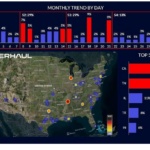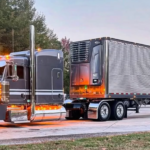Semi-trucks weigh somewhere between 35,000 and 80,000 pounds. That is a lot of weight to stop once it gets going, which is what makes the braking system so vital on a semi. Having a damaged, improperly functioning or worn-out brake system is a danger to all those on the roadways. Therefore, it’s important for drivers to be aware of brake issues that could plague their rig and know what signs to look for to get ahead of the problem.
What Kind of Brakes Do Semi Trucks Use?
Before looking at what can go wrong, one should consider the makeup of the semi-truck brakes themselves. Most semi-trucks utilize a brake system consisting of three parts. This includes air brakes, parking brakes, and emergency brakes. The overall system is cleverly designed and works amazingly well in most cases. Air brakes utilize friction, which is applied to the brake pad to compress the air that’s stored within the truck’s tank to push against a piston that will put pressure on the brake pad. Parking brakes are another element of the system, and they keep the rig from rolling away when parked, hence the name. Emergency brakes, as one might imagine, are equally important to large machines like big rigs. Some rigs are even equipped with automatically engaging emergency brakes, though others must be manually engaged.
Common Semi-Truck Brake Issues
The following are some of the most common causes of semi brake issues:
Imbalanced Brakes: Brake shoes come in pairs. Therefore, they are meant to wear evenly. However, in some cases, they become imbalanced and wear improperly or unevenly. This makes one side weaker and can lead to brake issues. Signs of this include squeaking or scraping noises or a truck that is less responsive to braking than designed.
- Improper Loading: Loading a rig correctly is vitally important as improper loading can cause all sorts of issues, not excluding problems stopping.
- Improper maintenance: Brakes, as well as many other aspects of a semi, need to be constantly maintained to ensure they are working as designed. We aren’t talking about a minor problem if a huge semi-truck can’t stop. This is serious. So, maintenance is a must, especially for the braking system and the emergency backups.
- Over-braking: Drivers don’t want to overtax the braking system by braking needlessly or using excessive force.
- Brake Fade: Brake fades occur when drivers inadvertently overheat the brake drums by over-braking or over-pumping the brakes. Brakes fades are a weakness of the air brake system. Creating this issue can be avoided by using short, hard, intermittent brake applications instead of holding the brakes for long periods of time.
- Brake Lock: This happens when the brake shoe on the truck becomes stuck. Signs of this include a sluggish acceleration, almost like the truck is being held back. This is because the shoe is struggling to release itself after being engaged.
- Damaged Airline: Due to its air system, brakes can become damaged when certain parts of the truck’s airline itself are either punctured, cracked or broken. This means the air is no longer being pressurized properly and can lead to ineffective braking.
What To Do if You Experience Brake Failure
There is nothing scarier for a truck driver than being unable to make their rig stop due to brake issues. Some ways experienced drivers can offset these issues and keep themselves and others on the roadways safe are as follows:
- Downshift
- Use the emergency brake to stop.
- Pump brakes (if hydraulic)
- Find an escape route
- Use an escape ramp
Keep all the information outlined above in mind to ensure the semi brake system is functioning properly.
Source: www.driveknight.com





